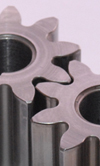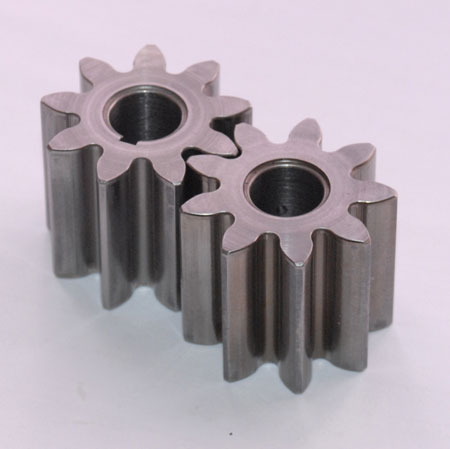Pump gear teeth
 What is the difference between a gear tooth in a gearbox and that in an oil pump? In case you were expecting some form of witty answer I'm afraid I'll have to disappoint you. For although at first glance the two might appear to be the same, in reality the tasks they are being asked to undertake are very different.
What is the difference between a gear tooth in a gearbox and that in an oil pump? In case you were expecting some form of witty answer I'm afraid I'll have to disappoint you. For although at first glance the two might appear to be the same, in reality the tasks they are being asked to undertake are very different.
In the case of the transmission, the object is to transfer the tangential force from one rotating shaft to that of another, while for the pump it is not so much the transfer of force but that of the motion of the trapped fluid. Looked at in this way, it must be clear that when asked to perform different tasks, the design of the gears must be subtly different.
In transmitting motion between parallel shafts, external spur gears are the ones most often used for gear pumps and transmissions alike. The side or flank of the tooth, that which does all the pushing work, is usually shaped in the form of an involute and is essentially unchanged between the two.
At the base of the profile, where this flank meets the body of the gear, is the fillet radius or root while at the top, where the flank meets the outside radius, is the tip. For transmissions where shaft misalignment under load can easily occur, the tip can often be crowned to provide relief. Also, since the teeth can be heavily loaded, provision has to be made at the base of the tooth to ensure that the profile blends into the root diameter. This has to be big enough to minimise stress concentrations but not so big as to weaken the tooth overall.
When it comes to gear pumps, however, the loads experienced are nowhere near those in a gearbox, so 'crowning' at the tip of the tooth is not as necessary and - dare I say it - even undesirable. Indeed, its provision may actually reduce pumping efficiency as a result of excessive leakage. Since the tooth bending loads are also smaller, the root radius can be also be reduced.

In essence, and in terms that gear people might recognise, the best gears are those that have been cut to the whole depth. It is essential therefore that the root radius is kept as small as possible to keep clearances to a minimum.
In the real world though, the temptation is for pressure and scavenge pump manufacturers to use standard 'off-the-peg' components. Made in thousands under closely controlled conditions, these will be much more accurate and with fewer defects, making them very much cheaper than any bespoke units likely to be produced. Designed for power transmission, they will most likely have relieved tips and larger root radii than perhaps is ideal, but the quality of manufacture and the accuracy of the profile will more than make up for any loss in pumping efficiency.
Although the requirements between the gears of a transmission and that of a pump may differ in a number of significant details, in reality - though it hurts me to say so - the actual differences are likely to be very little, if any at all.
Fig. 1 - Shaft or pump gears?
Written by John Coxon